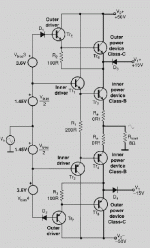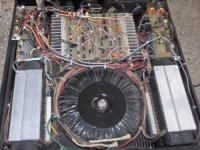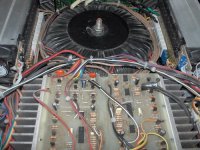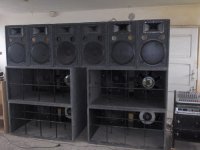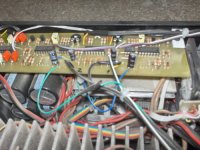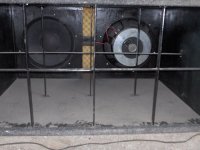Mikeks, your first link is the same link I had in my post for what Class GH hybrid is, fixed DC rail with rail tracking when the AB amp needs to go higher than the DC rail. I believe the slew rate of the supply will need to have a higher slew rate. This is similar to Douglas Self's conclusion that a regulated supply is better as long as the supply is faster than the amplifier. As an experiment, power a small AB amp, like 20W from a higher powered AB amp as the rails that is faster than the small AB amp. Then measure THD and compare it to a unregulated supply or slower bench fixed supplies.
I am using Douglas Self's definition of Class G and H.
When ever you see a new class like Class I or Class T be skeptical. Class T is not a real class, just marketing (T after Tripath, Tripath is from the founder's last name). Class I is Class BD, same type of modulation that TI uses in their Class D chips just Crown uses a new name of their own choosing. BTW, Class AD does not need to be bridged but Class BD does need to be bridged to get 3 states. Rockford Fosgate has a patent on a Class BD design, I didn't see it on Toino's list. It is patent number 6097249. It is a very interesting read. Thanks for the links. I will have to take some time to look at them.
Class TD sounds just like what I have learned is Class H which says nothing about how the supply rail tracking is created but one would almost assume Class D for efficiency reasons. I don't understand what Workhorse is calling Class H. If you have some links it would be helpful or more explanations. See the BASH amplifier link in my earlier post or in Mikeks post (elegant link).
Sorry to side track the thread so much. I have heard of ideas where you use a Class D to create the output and drive the current but then in parallel with a small AB amp to correct the waveform some and improve THD but over efficiency gain is good or change from class AB into D at some level. Hence, Class AB+D. I have seen a chip do AB into D (can't say where 😉) but getting THD good is the challege. The D in parallel with an AB sounds interesting but that is all I know about it so want to understand more.
-SL
I am using Douglas Self's definition of Class G and H.
When ever you see a new class like Class I or Class T be skeptical. Class T is not a real class, just marketing (T after Tripath, Tripath is from the founder's last name). Class I is Class BD, same type of modulation that TI uses in their Class D chips just Crown uses a new name of their own choosing. BTW, Class AD does not need to be bridged but Class BD does need to be bridged to get 3 states. Rockford Fosgate has a patent on a Class BD design, I didn't see it on Toino's list. It is patent number 6097249. It is a very interesting read. Thanks for the links. I will have to take some time to look at them.
Class TD sounds just like what I have learned is Class H which says nothing about how the supply rail tracking is created but one would almost assume Class D for efficiency reasons. I don't understand what Workhorse is calling Class H. If you have some links it would be helpful or more explanations. See the BASH amplifier link in my earlier post or in Mikeks post (elegant link).
Sorry to side track the thread so much. I have heard of ideas where you use a Class D to create the output and drive the current but then in parallel with a small AB amp to correct the waveform some and improve THD but over efficiency gain is good or change from class AB into D at some level. Hence, Class AB+D. I have seen a chip do AB into D (can't say where 😉) but getting THD good is the challege. The D in parallel with an AB sounds interesting but that is all I know about it so want to understand more.
-SL
The patent number 6097249 is not in the list because is not a tracking supply, is just 3 level class-D.
About class-I patent the only thing I could see is two Buck converters, one positive the other negative. For me is a kind of switched class AB amplifier.
The irony of the list is that the patents are almost the some.
I steel not understand how it is possible to patent the some thing so many times…😕
About class-I patent the only thing I could see is two Buck converters, one positive the other negative. For me is a kind of switched class AB amplifier.
The irony of the list is that the patents are almost the some.
I steel not understand how it is possible to patent the some thing so many times…😕
---Class-G= Cascode Connected series Devices at outputs---
Cascade, yes; cascode, I don't think so.
Cascade, yes; cascode, I don't think so.
...and this is class-H:
http://www.diyaudio.com/forums/showthread.php?postid=899075#post899075
http://www.diyaudio.com/forums/showthread.php?postid=773084#post773084
...and Forr , as you can see on Workhorse sch, class-G is a kind of cascode.
http://www.diyaudio.com/forums/showthread.php?postid=899075#post899075
http://www.diyaudio.com/forums/showthread.php?postid=773084#post773084
...and Forr , as you can see on Workhorse sch, class-G is a kind of cascode.
SpittinLLama said:........This is similar to Douglas Self's conclusion that a regulated supply is better as long as the supply is faster than the amplifier. .......
I don't think Self arrived at any such conclusion...

Are you guys saying the only difference between Class G and Class H is how the output stage is connected? What Toino linked calling Class H looks to me like Class G, rails jump as necessary. So what is the class where the supply follows the output at a few volts higher than the output to keep the xsistors out of saturation or think of infinite rail jumps with infinite levels to jump?
Maybe I am paraphrasing Self or I have him confused with another author. I'll see if I can clarify by getting the reference.
-SL
Maybe I am paraphrasing Self or I have him confused with another author. I'll see if I can clarify by getting the reference.
-SL
You are correct Mikeks, I did not find this conclusion in the book I have by Self. He pretty much recommends the unregulated supply route with the amplifier correctly designed for such. I can't remember where I read it but it is not something I learned on my own. Couldn't find it quickly in my other books and time is tight right now.
-SL
-SL
SpittinLLama said:So what is the class where the supply follows the output at a few volts higher than the output
Ahh! that one! nothing to do with class-G or class-H.
These gentlemen call it class TD:
http://www.labgruppen.com/media/C_TB_classTD_SMPS_intercooler_v2(1).pdf
And these gentlemen call it EEEngine:
http://www.yamaha.co.jp/english/product/proaudio/products/power_amps/p7000s/features.html
And these gentlemen call it Tracking Downconverter™:
http://www.sunfire.com/pdf/sunwhite03.pdf
All the gentlemen above are on the patent list posted few days ago...
Hi Workhouse,
I apolologize, you're right. In a class G amp, the outer devices and the inner devices work as followers in a cascode mode. The first time I've seen this kind of followers was in a paper written by Nelson Pass. However, I do not remember Self using the term "cascode" for his class G amp, whihc should explain my mistake.
Hi SpittinLLama,
---This is similar to Douglas Self's conclusion that a regulated supply is better as long as the supply is faster than the amplifier. ......
[...]
I can't remember where I read it but it is not something I learned on my own.---
May be it was in a Crimson amplifiers note which, like Self, does not recommend regulated supplies "which should have to be better than the amp itself", it said, I think.
I apolologize, you're right. In a class G amp, the outer devices and the inner devices work as followers in a cascode mode. The first time I've seen this kind of followers was in a paper written by Nelson Pass. However, I do not remember Self using the term "cascode" for his class G amp, whihc should explain my mistake.
Hi SpittinLLama,
---This is similar to Douglas Self's conclusion that a regulated supply is better as long as the supply is faster than the amplifier. ......
[...]
I can't remember where I read it but it is not something I learned on my own.---
May be it was in a Crimson amplifiers note which, like Self, does not recommend regulated supplies "which should have to be better than the amp itself", it said, I think.
I don't know guys, I think the tracking rail design is Class H and all others that only have fixed rails but jumps between them is Class G. Just doesn't make much sense, the difference between Class G and H you guys are showing me is really minimal. The ideas for almost all classes have been around for decades including Class D, way before they could actually be implemented. Anyway, thanks for the information and links. Based on the Power dissipation plots on that Yamaha page it looks more like couple different rails than a modulated supply. Still gotta download all those patents for fun.
-SL
-SL
SpittinLLama said:I don't know guys, I think the tracking rail design is Class H and all others that only have fixed rails but jumps between them is Class G. Just doesn't make much sense, the difference between Class G and H you guys are showing me is really minimal. The ideas for almost all classes have been around for decades including Class D, way before they could actually be implemented. Anyway, thanks for the information and links. Based on the Power dissipation plots on that Yamaha page it looks more like couple different rails than a modulated supply. Still gotta download all those patents for fun.
-SL
The Real Difference between Class-H & Class-G
In Class-G the switching from Lower Tier to Upper Tier is linear and its amplitude is proportional to the output voltage....
In Class-H the switching from Lower Tier to Upper Tier is Steep Stepped Square wave whose amplitude remains constant[equals to upper Tier voltage] but the width of envelope changes according to the output voltage amplitude...
Donot relate Tracking Rail [Class-TD]designs to confuse with Class-H, the literature from which your are taking reference is not correct at all...
regards,
K a n w a r
- Status
- Not open for further replies.
- Home
- Amplifiers
- Solid State
- Class AB+D schematics
